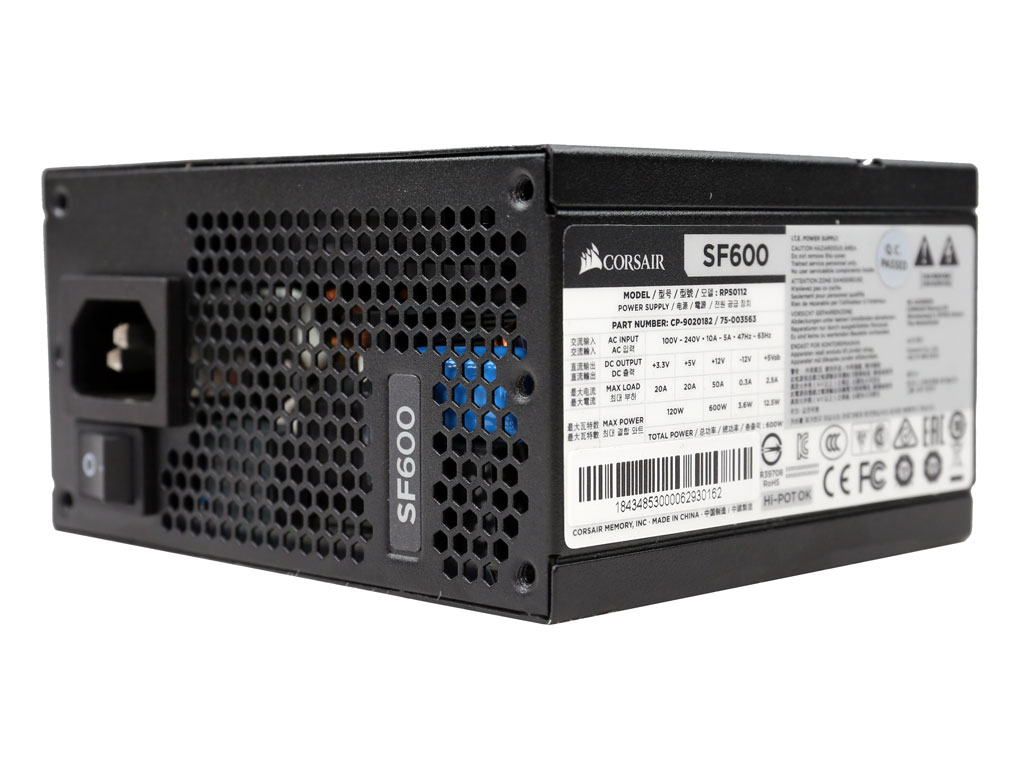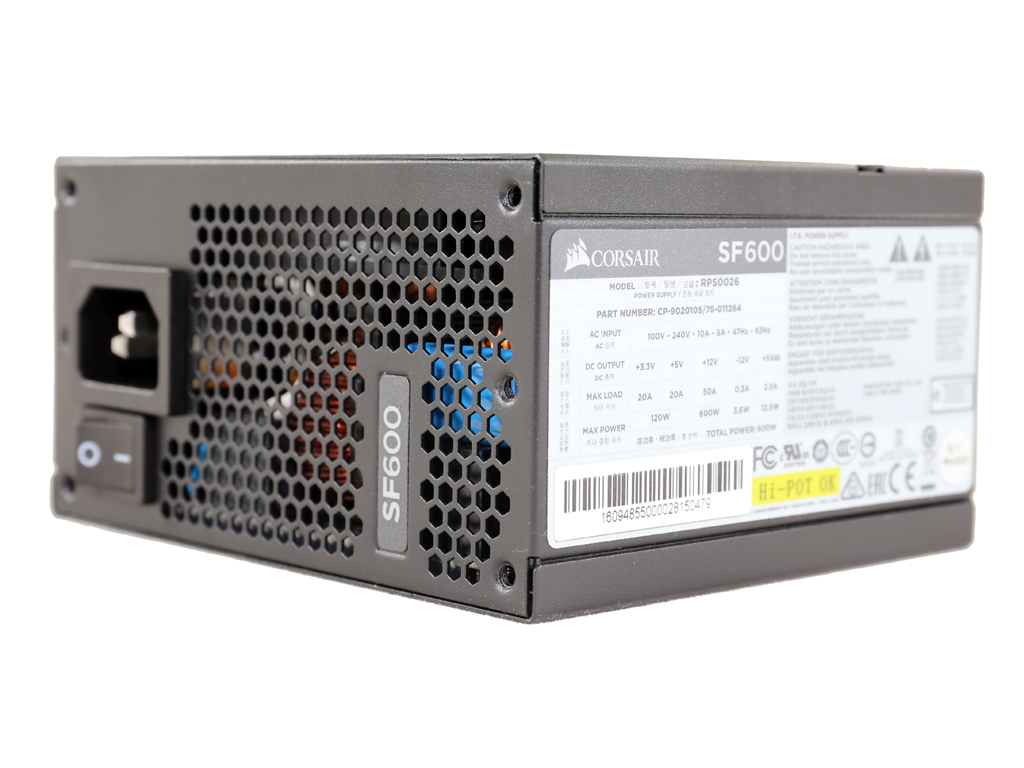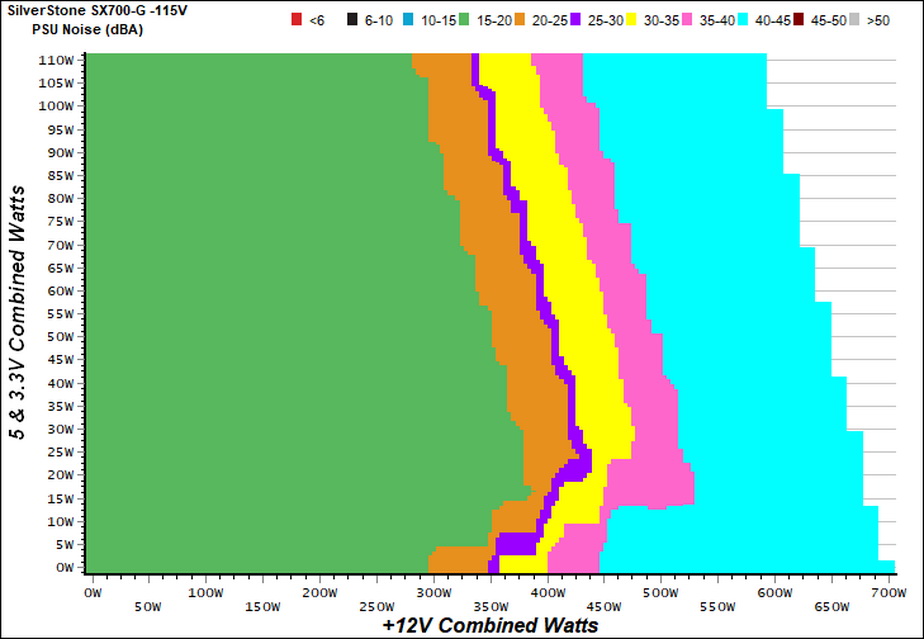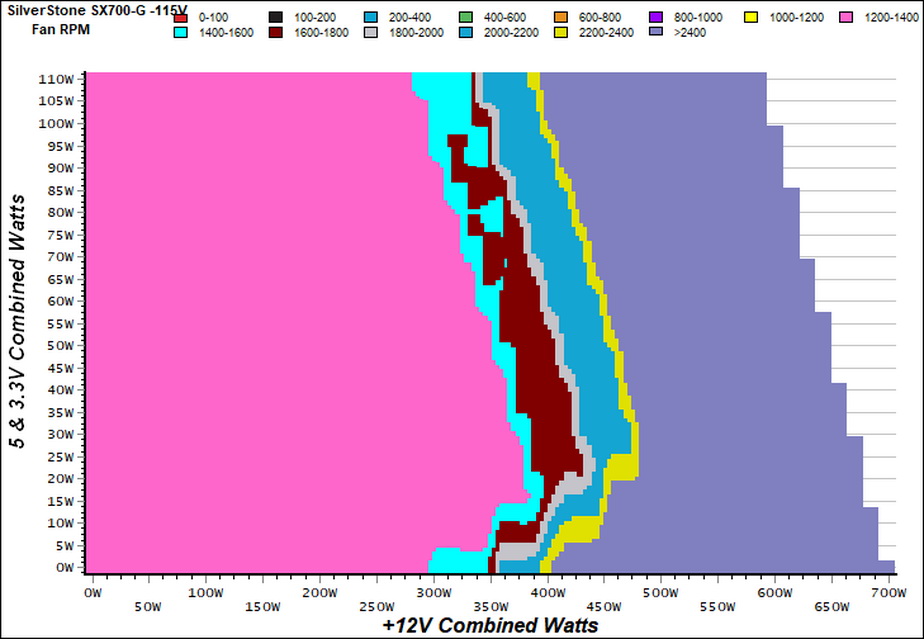SilverStone SX700-G PSU Review: An Overclocked SX650-G?
Why you can trust Tom's Hardware
Load Regulation, Hold-Up Time, Inrush Current, Efficiency & Noise
To learn more about our PSU tests and methodology, please check out How We Test Power Supply Units.
Primary Rails And 5VSB Load Regulation
The following charts show the main rails' voltage values recorded between a range of 40W up to the PSU's maximum specified load, along with the deviation (in percent). Tight regulation is an important consideration every time we review a power supply because it facilitates constant voltage levels despite varying loads.
Tight load regulation improves system stability, especially under overclocked conditions. At the same time, it applies less stress to the DC-DC converters that many system components utilize.
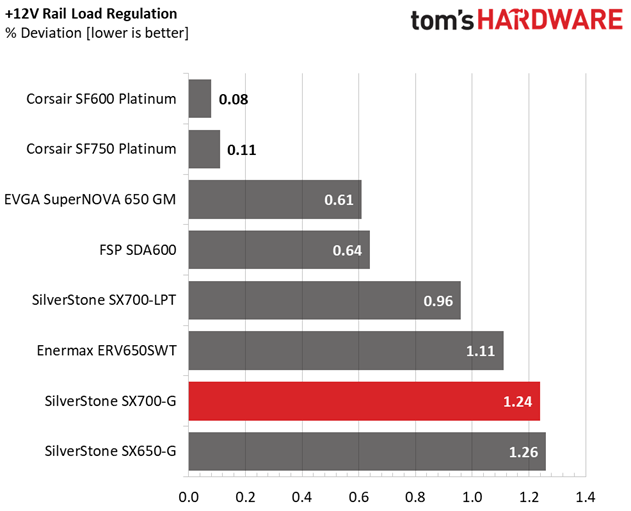


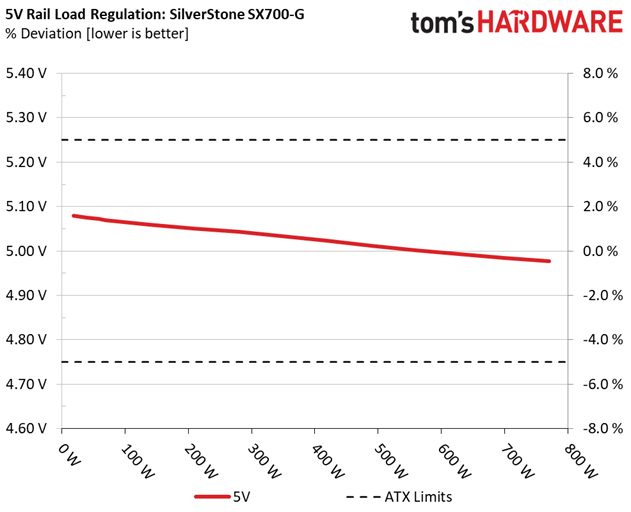
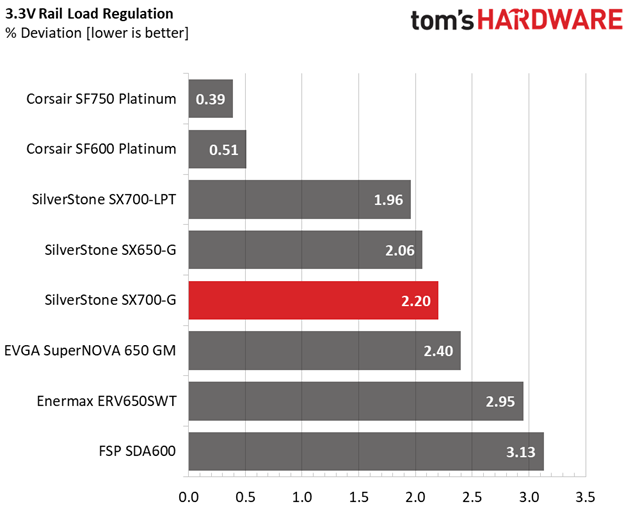
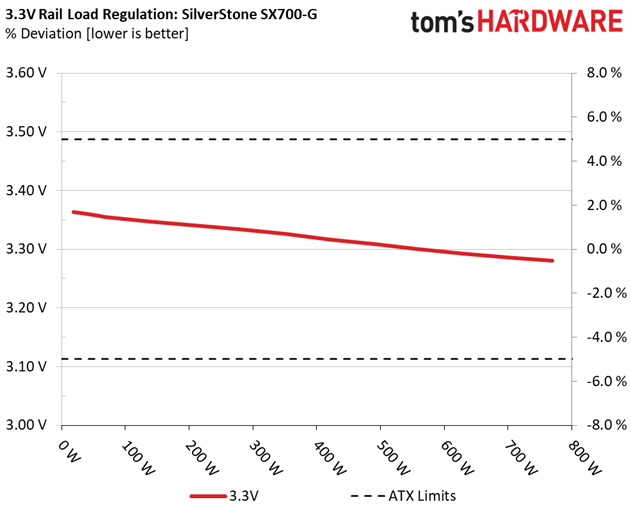
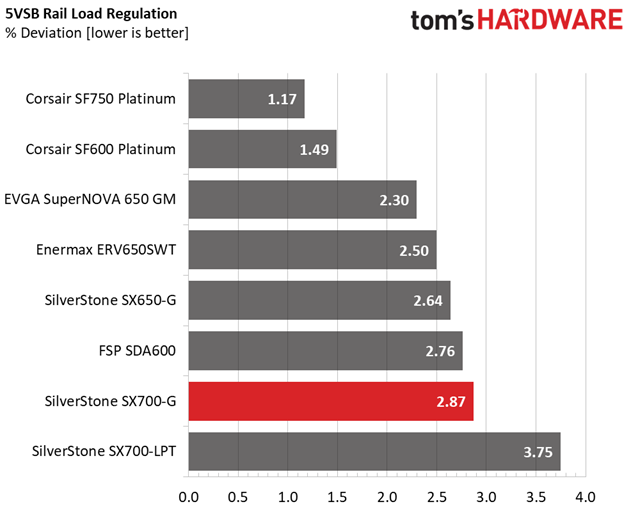
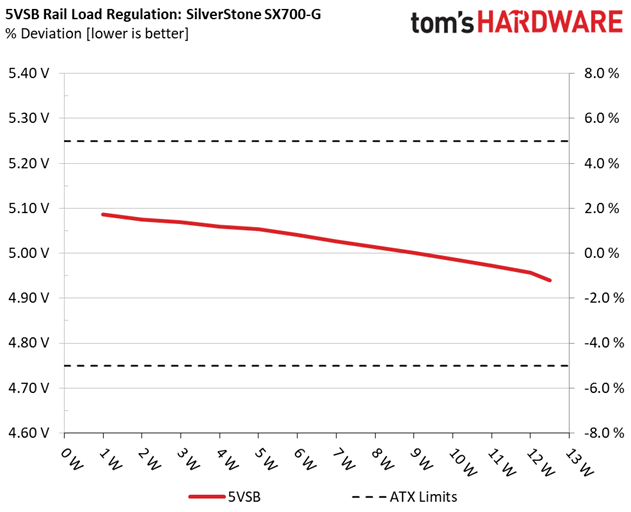
SilverStone's load regulation isn't particularly tight on every rail. The Corsair SF family clearly dominates in this discipline.
Hold-Up Time
Put simply, hold-up time is the amount of time that the system can continue to run without shutting down or rebooting during a power interruption.
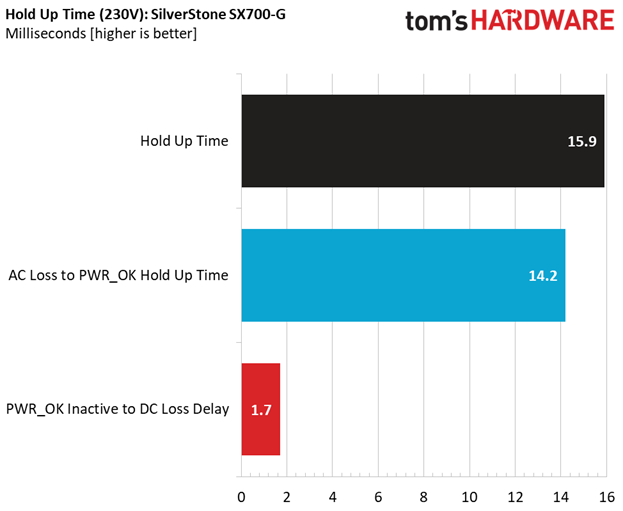
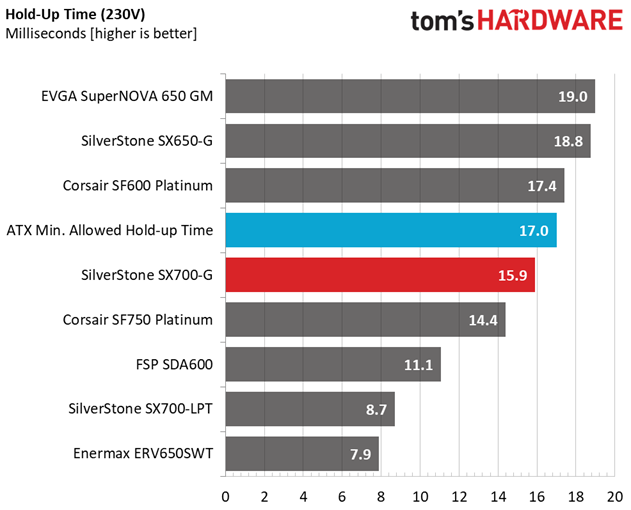
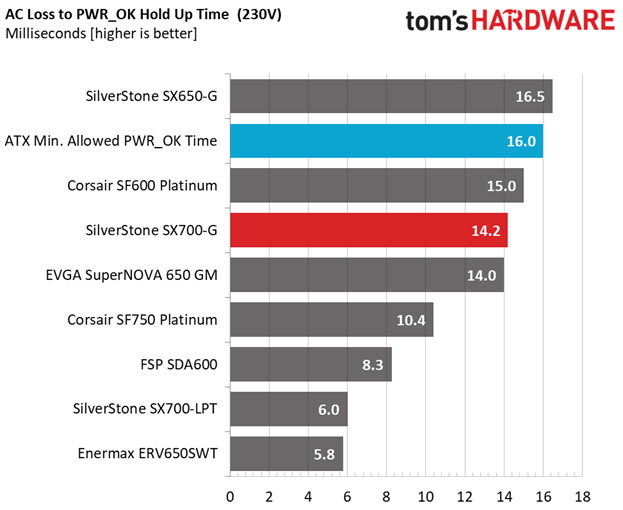
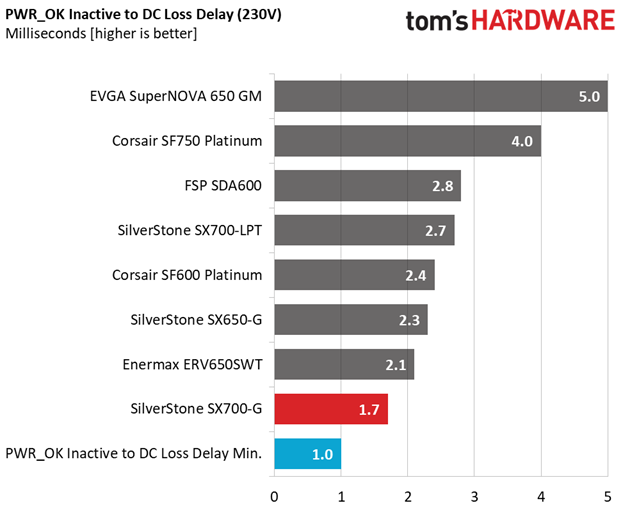
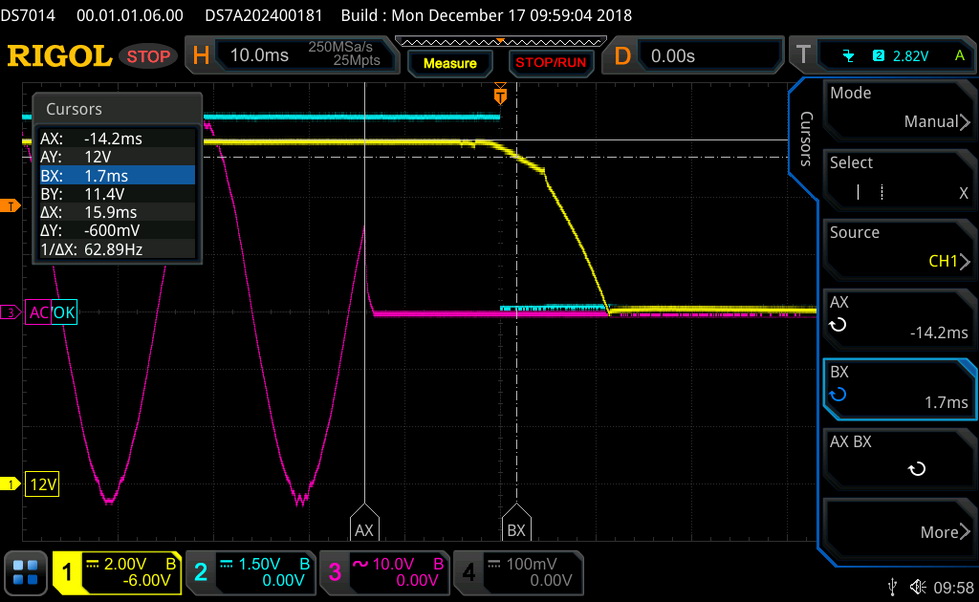

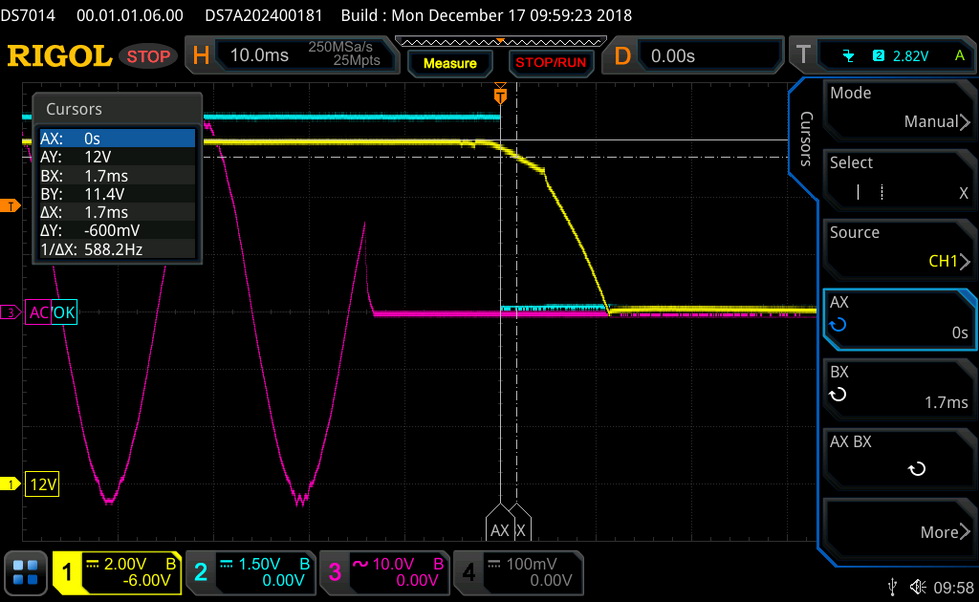
The hold-up time we measured is closer to 17ms than we expected, while the power-good signal is accurate. It would be nice if SilverStone used a larger bulk cap, rather than the same one we found in the SX650-G. Nevertheless, the SX700-G takes the lead from its principal competition, Corsair's SF750, in these tests.
Inrush Current
Inrush current, or switch-on surge, refers to the maximum, instantaneous input current drawn by an electrical device when it is first turned on. A large enough inrush current can cause circuit breakers and fuses to trip. It can also damage switches, relays, and bridge rectifiers. As a result, the lower the inrush current of a PSU right as it is turned on, the better.
Get Tom's Hardware's best news and in-depth reviews, straight to your inbox.


Measured inrush currents are at normal levels.
10-110% Load Tests
These tests reveal the SX700-G’s load regulation and efficiency levels under high ambient temperatures. They also show how the fan speed profile behaves under tough operating conditions.
| Test # | 12V | 5V | 3.3V | 5VSB | DC/AC (Watts) | Efficiency | Fan Speed | PSU Noise | Temps (In/Out) | PF/AC Volts |
|---|---|---|---|---|---|---|---|---|---|---|
| 1 | 3.947A | 1.971A | 1.962A | 0.989A | 69.454 | 82.827% | 1285 RPM | 16.8 dB(A) | 40.21°C | 0.976 |
| 12.131V | 5.069V | 3.355V | 5.054V | 83.854 | 44.34°C | 115.07V | ||||
| 2 | 8.966A | 2.964A | 2.957A | 1.190A | 139.522 | 88.030% | 1290 RPM | 16.8 dB(A) | 41.71°C | 0.991 |
| 12.116V | 5.059V | 3.347V | 5.041V | 158.494 | 46.59°C | 115.06V | ||||
| 3 | 14.331A | 3.464A | 3.439A | 1.393A | 209.508 | 90.380% | 1298 RPM | 17.0 dB(A) | 42.15°C | 0.992 |
| 12.108V | 5.051V | 3.341V | 5.027V | 231.807 | 47.45°C | 115.10V | ||||
| 4 | 19.711A | 3.966A | 3.955A | 1.596A | 279.515 | 90.871% | 1296 RPM | 16.9 dB(A) | 42.51°C | 0.994 |
| 12.091V | 5.043V | 3.334V | 5.014V | 307.594 | 47.96°C | 115.49V | ||||
| 5 | 24.775A | 4.967A | 4.958A | 1.800A | 349.650 | 90.816% | 1296 RPM | 16.9 dB(A) | 42.46°C | 0.995 |
| 12.075V | 5.033V | 3.326V | 5.001V | 385.009 | 49.26°C | 115.15V | ||||
| 6 | 29.853A | 5.972A | 5.968A | 2.006A | 419.764 | 90.379% | 1626 RPM | 24.1 dB(A) | 42.63°C | 0.996 |
| 12.058V | 5.023V | 3.317V | 4.987V | 464.448 | 49.61°C | 115.15V | ||||
| 7 | 34.947A | 6.983A | 6.979A | 2.213A | 489.891 | 89.748% | 2096 RPM | 33.2 dB(A) | 43.08°C | 0.997 |
| 12.041V | 5.012V | 3.309V | 4.972V | 545.852 | 50.90°C | 115.07V | ||||
| 8 | 40.060A | 7.998A | 7.999A | 2.421A | 560.036 | 88.992% | 2609 RPM | 39.4 dB(A) | 43.98°C | 0.997 |
| 12.023V | 5.001V | 3.300V | 4.957V | 629.311 | 52.35°C | 115.07V | ||||
| 9 | 45.581A | 8.512A | 8.502A | 2.424A | 629.742 | 88.367% | 2860 RPM | 42.2 dB(A) | 44.50°C | 0.997 |
| 12.006V | 4.993V | 3.293V | 4.950V | 712.643 | 53.72°C | 115.10V | ||||
| 10 | 51.116A | 9.031A | 9.036A | 2.531A | 700.087 | 87.629% | 2857 RPM | 42.2 dB(A) | 45.55°C | 0.997 |
| 11.990V | 4.984V | 3.286V | 4.940V | 798.925 | 55.41°C | 115.10V | ||||
| 11 | 57.009A | 9.046A | 9.052A | 2.535A | 769.729 | 86.775% | 2854 RPM | 42.2 dB(A) | 46.66°C | 0.997 |
| 11.972V | 4.977V | 3.280V | 4.933V | 887.037 | 57.27°C | 115.07V | ||||
| CL1 | 0.132A | 13.000A | 12.999A | 0.000A | 109.953 | 82.341% | 1320 RPM | 17.4 dB(A) | 42.28°C | 0.992 |
| 12.128V | 5.019V | 3.316V | 5.066V | 133.533 | 49.87°C | 115.09V | ||||
| CL2 | 58.340A | 1.001A | 0.998A | 1.000A | 712.772 | 88.087% | 2870 RPM | 42.4 dB(A) | 45.43°C | 0.997 |
| 11.989V | 5.017V | 3.315V | 5.002V | 809.167 | 55.54°C | 115.08V |
Up through the 60% load test, SilverStone's fan noise is low. However, it notably increases in the following two tests. At 90% of its maximum-rated capacity and higher, the fan rotates at its peak speed, generating a raucous 42+ dB(A).
20-80W Load Tests
In the following tests, we measure the SX700-G's efficiency at loads significantly lower than 10 percent of its maximum capacity (the lowest load the 80 PLUS standard measures). This is important for representing when a PC is idle, with power-saving features turned on.
| Test # | 12V | 5V | 3.3V | 5VSB | DC/AC (Watts) | Efficiency | Fan Speed | PSU Noise | PF/AC Volts |
|---|---|---|---|---|---|---|---|---|---|
| 1 | 1.169A | 0.490A | 0.473A | 0.197A | 19.278 | 61.101% | 1273 RPM | 16.8 dB(A) | 0.908 |
| 12.145V | 5.079V | 3.363V | 5.086V | 31.551 | 115.07V | ||||
| 2 | 2.428A | 0.983A | 0.979A | 0.394A | 39.756 | 65.592% | 1279 RPM | 16.8 dB(A) | 0.969 |
| 12.141V | 5.075V | 3.360V | 5.075V | 60.611 | 115.06V | ||||
| 3 | 3.612A | 1.476A | 1.456A | 0.592A | 59.198 | 82.150% | 1282 RPM | 16.8 dB(A) | 0.979 |
| 12.133V | 5.072V | 3.357V | 5.069V | 72.061 | 115.06V | ||||
| 4 | 4.870A | 1.972A | 1.962A | 0.791A | 79.645 | 84.113% | 1283 RPM | 16.8 dB(A) | 0.979 |
| 12.129V | 5.068V | 3.354V | 5.059V | 94.688 | 115.07V |
Measured noise is low. But the same applies to the efficiency levels we recorded, too. In the first two tests, they're lower than 70%.
Efficiency
Next, we plotted a chart showing the SX700-G’s efficiency at low loads, and loads from 10 to 110 percent of its maximum-rated capacity. The higher a PSU’s efficiency, the less energy gets wasted as heat.
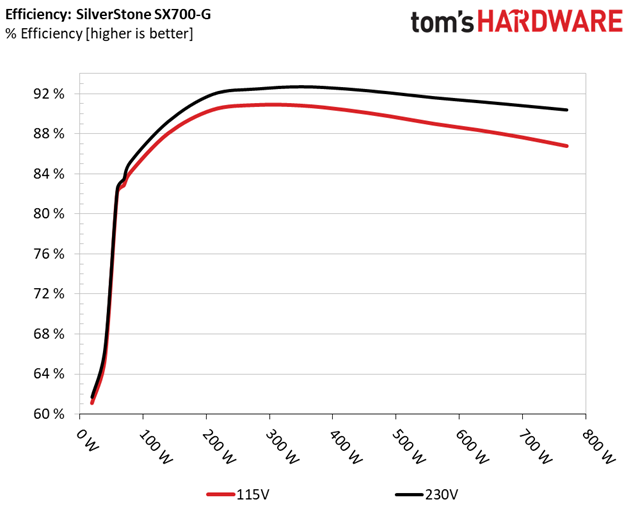
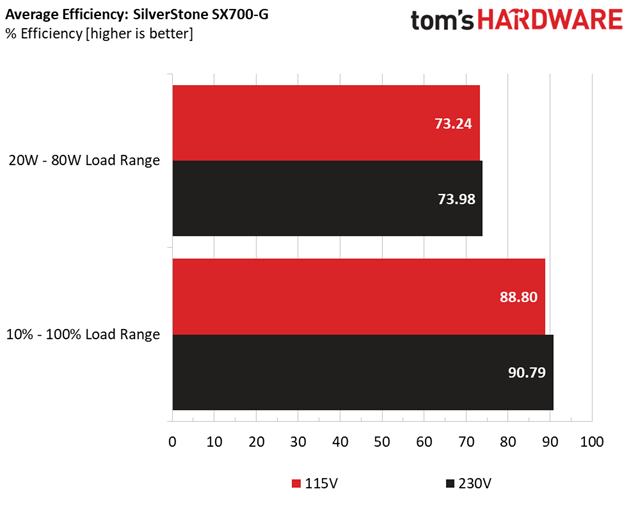
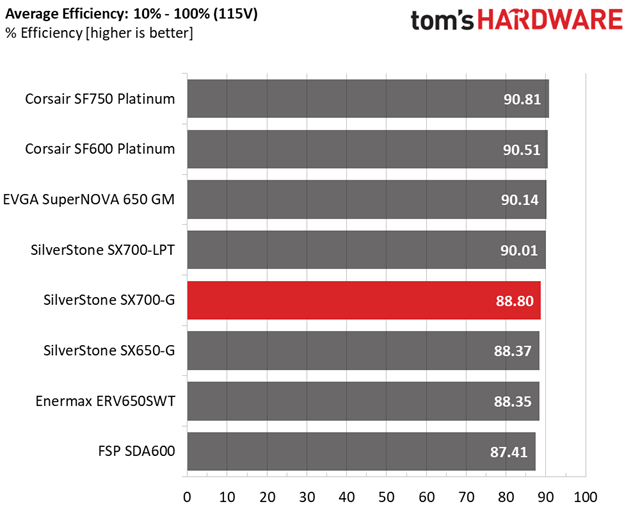

Efficiency is high enough under normal loads. However, that's not the case under light loads where the SX700-G lands in last place.
5VSB Efficiency
| Test # | 5VSB | DC/AC (Watts) | Efficiency | PF/AC Volts |
|---|---|---|---|---|
| 1 | 0.100A | 0.510 | 70.932% | 0.114 |
| 5.095V | 0.719 | 115.09V | ||
| 2 | 0.250A | 1.272 | 75.490% | 0.217 |
| 5.089V | 1.685 | 115.09V | ||
| 3 | 0.550A | 2.794 | 80.241% | 0.310 |
| 5.079V | 3.482 | 115.09V | ||
| 4 | 1.000A | 5.067 | 81.871% | 0.368 |
| 5.066V | 6.189 | 115.09V | ||
| 5 | 1.500A | 7.576 | 81.938% | 0.400 |
| 5.050V | 9.246 | 115.09V | ||
| 6 | 2.500A | 12.551 | 81.126% | 0.434 |
| 5.020V | 15.471 | 115.09V |
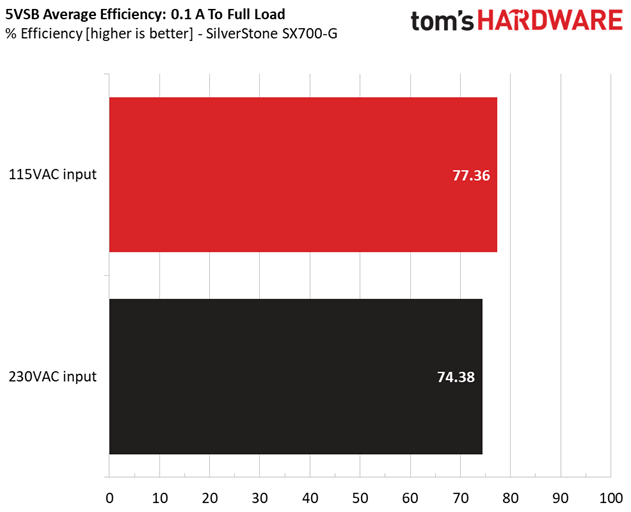
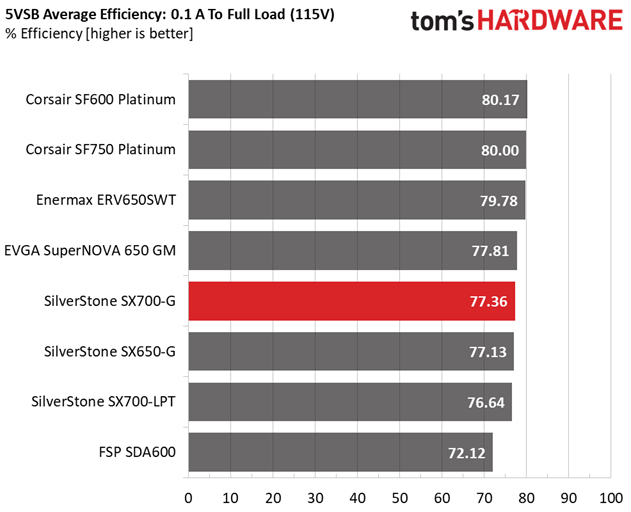
The 5VSB rail achieves high efficiency levels.
Power Consumption In Idle And Standby
| Mode | 12V | 5V | 3.3V | 5VSB | Watts | PF/AC Volts |
|---|---|---|---|---|---|---|
| Idle | 12.142V | 5.082V | 3.364V | 5.096V | 5.888 | 0.502 |
| 115.1V | ||||||
| Standby | 0.092 | 0.016 | ||||
| 115.1V |
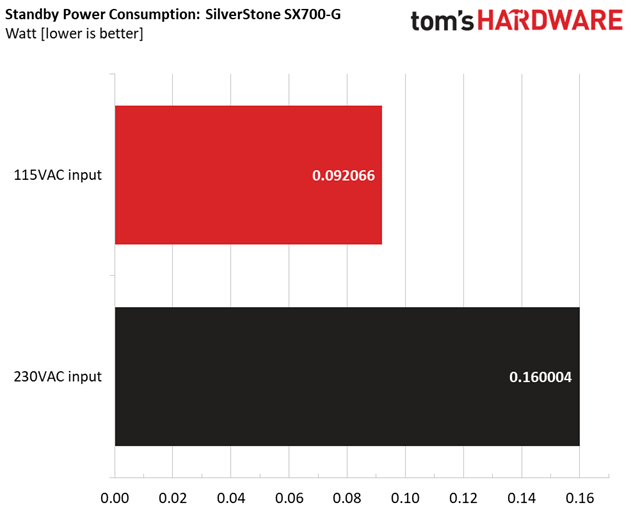
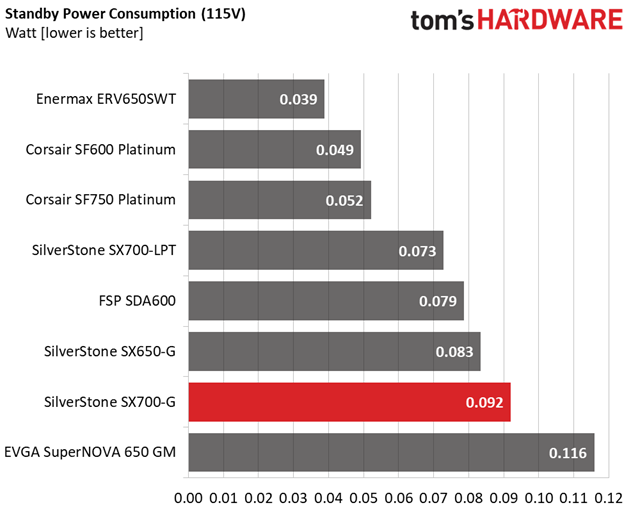
We measure high vampire power levels, at least compared to the competition. This is the reason why SilverStone's 5VSB rail isn't particularly efficient under very light loads.
Fan RPM, Delta Temperature, And Output Noise
All of our results are obtained between 37°C (98.6°F) to 47°C (116.6°F) ambient temperature.
The following results are obtained between 30°C (86°F) to 32°C (89.6°F) ambient temperature.
In a range between 1,200 and 1,400 RPM, the fan's minimum speed is quite high. With that said, it's very hard to achieve lower rotational speeds without PWM control.
Up through 350W of load the SX700-G is quiet, generating less than 25 dB(A). But with merely 50W more, it jumps up above 35 dB(A). We think that the fan speed profile should ramp up more smoothly as load increases.
MORE: Best Power Supplies
MORE: How We Test Power Supplies
MORE: All Power Supply Content
Current page: Load Regulation, Hold-Up Time, Inrush Current, Efficiency & Noise
Prev Page Specifications and Component Analysis Next Page Protection Features, DC Power Sequencing, Cross-Load Tests & Infrared Images
Aris Mpitziopoulos is a contributing editor at Tom's Hardware, covering PSUs.
